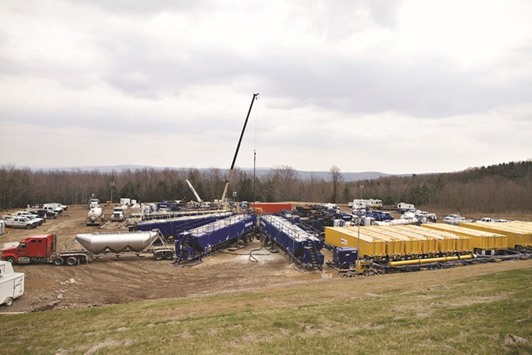A landmark study by the US Environmental Protection Agency that concluded fracking causes no widespread harm to drinking water is coming under fire - this time, from the agency’s own science advisers.
The EPA’s major finding in June’s preliminary report, that there’s no evidence fracking has led to “widespread, systemic impacts on drinking water,” was seen as a vindication of hydraulic fracturing.
A repudiation of the results could reignite the debate over the need for more regulation.
Members of the EPA Science Advisory Board, which reviews major studies by the agency, said in a report released on Thursday the agency’s main conclusion “is ambiguous and requires clarification.”
The major findings “are inconsistent with the observations, data and levels of uncertainty” presented in the rest of EPA’s water study, the 31-member panel said. The panel will deliberate over the draft recommendations it issued Thursday during a public teleconference on February 1, and possibly further revise them before sending final advice to EPA.
The scientific panel’s recommendations aren’t binding and the EPA is not required to change its study to accommodate them. But they already are raising questions about the most comprehensive assessment yet of a practice that has driven a domestic oil and gas boom but also spawned complaints about water contamination.
An EPA spokeswoman said the agency will use comments from the scientists and the public to “evaluate” possible changes to the report.
A significant change could be a big blow to an industry that is celebrating major policy wins, including the end of trade restrictions that for four decades blocked the export of most raw, unprocessed US crude.
Fracking, also known as hydraulic fracturing, involves pumping water, sand and chemicals underground to free oil and gas trapped inside dense rock formations.
For the congressionally mandated study, the EPA analysed more than 3,500 sources of information, including previously published papers, state reports and the agency’s own scientific research, but found no clear evidence that the fracking process itself could cause chemicals to flow through underground fissures and immediately contaminate drinking water. The agency did say that injecting fluids into formations that also contain drinking water resources “directly affects the quality of that water.”
When the agency took a broader look at the entire water cycle around fracking - from getting water supplies to disposing of fluid waste - it documented instances where failed wells and above-ground spills may have affected drinking water resources.
Robust peer review by the EPA’s Science Advisory Board, established by Congress in 1978, is designed to ensure the integrity of scientific reports, agency spokeswoman Melissa Harrison said in an e-mail.
She said the agency will use the comments from the advisory panel, as well as those submitted by the public, “to evaluate how to augment and revise the draft assessment.”
“The final assessment will also reflect relevant literature published since the release of the draft assessment,” Harrison said.
For now, advisory board members want the final document to include more information about alleged contamination near drilling sites in Dimock, Pennsylvania, Parker County, Texas, and Pavillion, Wyoming - places “where hydraulic fracturing activities are perceived by many members of the public to have caused significant local impacts to drinking water sources.”
“Examination of these high-visibility cases is important,” the panel said, “so the public can understand the status of investigations in these areas, conclusions associated with the investigations, lessons learned for hydraulic fracturing practice if any, plans for remediation if any, and the degree to which information from these case studies can be extrapolated to other locations.”
Wyoming’s Department of Environmental Quality said in a report last month that there is a “negligible” likelihood that fracking was to blame for any water contamination in Pavillion. Senator James Inhofe, a Republican from Oklahoma, said Wyoming’s report supports EPA’s broad national conclusions last year.
“It is inexplicable why the Science Advisory Board has encouraged EPA to incorporate their three discredited studies into the agency’s final water study,” Inhofe said in a statement on Thursday. “It is irresponsible and a purposeful interjection of bad science in order to distort the factual narrative.”
The review panel’s request for EPA to clarify its top-line finding was foreshadowed during public meetings in October. When one of the panelists - University of California engineering professor Thomas Young - suggested a rewrite, the group broke out in spontaneous applause.
Industry lobbyists and trade groups are working to tamp down the panel’s criticism, with American Petroleum Institute president Jack Gerard casting it as the work of determined environmental activists opposed to fossil fuels.
“The science should be settled,” Gerard told reporters at a news conference. “There are a handful of people who are not happy with the outcome, and they continue to drive their agenda based on ideology, not based on the science.”
The API and the Independent Petroleum Association of America delivered a similar message in separate letters to the EPA.
Scott Segal, head of the policy resolution group at Bracewell & Giuliani in Washington, and a lobbyist who represents Range Resources Corp and other energy companies, said in an interview that the review board should disregard “anecdotal evidence presented by litigants in active cases.” By contrast, he added, “the overwhelming weight of scientific evidence is on the side of the regulated community.”

Water tanks, sand tanks, and compressors surround a natural gas well during hydraulic fracturing operations on a Chesapeake Energy Corp drill site in Bradford County, Pennsylvania, US (file). The EPA’s major finding in June’s preliminary report, that there’s no evidence fracking has led to u201cwidespread, systemic impacts on drinking water,u201d was seen as a vindication of hydraulic fracturing. A repudiation of the results could reignite the debate over the need for more regulation.


